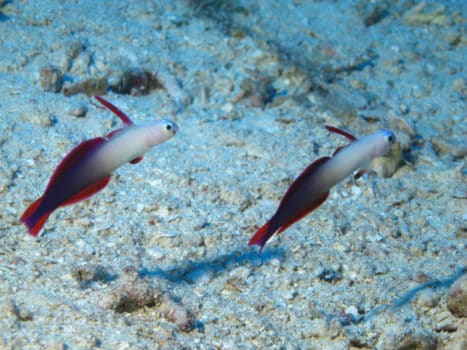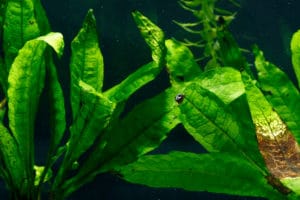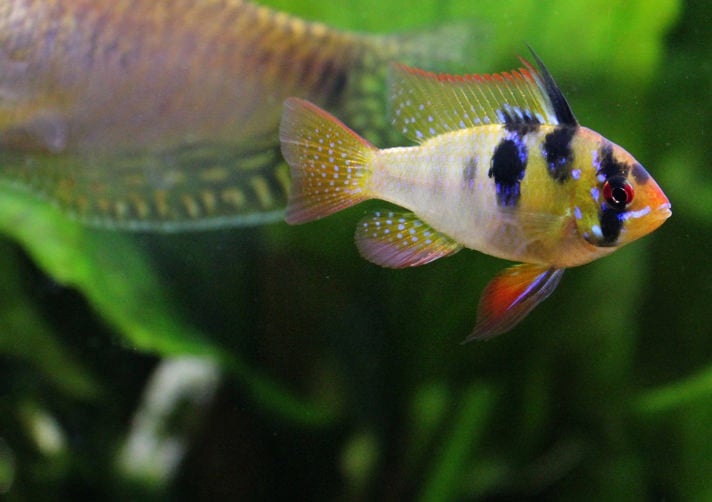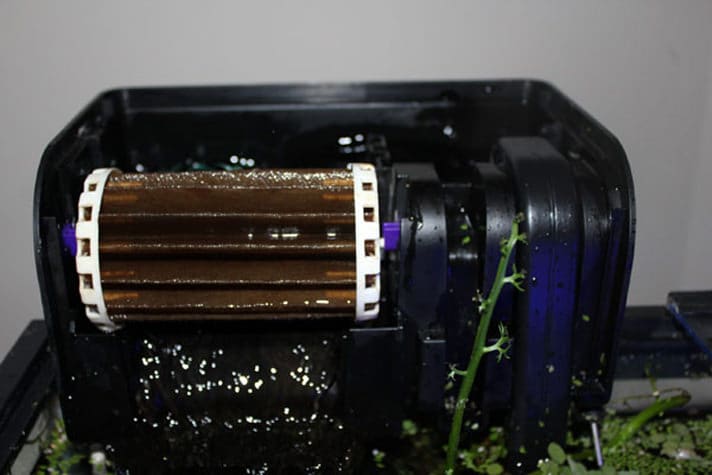Keeping a well-stocked and stable coldwater system can be one of the most challenging endeavors for a hobbyist, but it may turn out to be one of the most rewarding. Such a habitat in a home or office is a living work of art and can only be rivaled by a densely packed Indo-Pacific reef exhibit. The endeavor takes time, patience and a fairly significant monetary investment for the proper equipment, but for hobbyists who are truly passionate about coldwater habitats and not just looking for their next experiment, this may be the ultimate journey.
Find Your Fish
The best place to start is with animal selection. Find the fish first (or starfish, as the case may be)! Before embarking on the path of setting up a new coldwater system, possibly your first coldwater system attempt, find the one animal that will make it all worth it. This process requires time and money, so having a plan with an end goal in mind is important for keeping up momentum.
white-barred box fish
Opinions vary as to the ideal temperatures for the white-barred box fish (Anoplocapros lenticularis). It tolerates between 32 and 75 degrees Fahrenheit. Photo by bajoelmar/Wikimedia
When it comes to coldwater fish, there are a wide variety of shapes and sizes. Some favorites are grunt and sailfin sculpins, Catalina gobies, painted greenlings and saddleback gunnels for marine systems. However, when it comes to coldwater marine systems, it’s all about the invertebrates; those from the Pacific Northwest of the United States are a riot of color in a dreary gray-and-black world. Bright pinks and oranges predominate. Urchins, sea stars, anemones, mollusks like chitons, and deep-water corals make for an exciting exhibit.
Determining which animals will make the whole process worth the time and money will help answer all of the “what’s” for the life support. (What size tank? What temperature needs to be maintained?) Just as in tropical tanks, not all animals are compatible; one might eat the other or they might have different system requirements. Moreover, these animals are not readily in stock in most fish stores and must be ordered either through a shop or from the collectors directly if they sell to consumers.
Because of this low availability, prices for coldwater critters tend to be higher than the standard tropical animals that dominate the market. Knowing what livestock is available, attainable, and maintainable for hobbyists is vital. For example, wolf eels (Anarrhichthys ocellatus) are intriguing creatures, but they are hard to come by in the hobby, expensive at best, and can get up to 8 feet in length. Team that with an expensive diet, including crabs and mollusks, and it creates a perfect storm for frustration and disappointment. All animal purchases should be planned ahead of buying any equipment. Researching livestock options can be the difference between success and failure.
Planning Your Coldwater Tank
With the end livestock in mind, it’s time to turn to the tank itself. Just as in tropical systems, the tank size needs to be appropriate for the main display animal and in the quantity desired. For example, a Catalina goby can be kept in a nano tank as small as 10 gallons, but that would be inappropriate if the desired animal was a giant green anemone. Let the animals dictate the size of the main display tank, not just the amount of space chosen in a designated area for the system.
short-spine sea stars
Starfish of all varieties, including these short-spine sea stars (Pisaster brevispinus), will often require a coldwater system. Photo by Danielle Godshall
For the tank construction, an acrylic tank is strongly recommended for a coldwater system. A glass tank will not insulate the water nearly as well as acrylic. It is still doable with glass, but it may need a stronger chiller than an acrylic tank of the same dimensions. Also, glass builds up condensation faster than acrylic, so water droplets may need to be wiped away every time someone wants to view the animals. Acrylic will build condensation but slower than glass and sometimes not at all depending on external humidity and temperature. Glass aquariums are less expensive than acrylic ones, but when setting up a coldwater system, doing it right should be the only choice.
Choosing a Marine Tank Chiller
Obviously, coldwater systems will require the purchase of a chiller. This will be the most expensive purchase for the entire system. You might even need two chillers, but more on that later. Choosing the appropriate size chiller for the amount of water in the entire system and not just the total gallons in the tank is important. If the chiller is undersized, it will run constantly and fail quickly, running up the electric bill in the process. Here are some basics for chiller size based on system volume. It should be noted that these are just guidelines, not a definitive list.
Chiller strength will also vary between models and manufacturers. Using the chart above will help narrow the search, but only a careful inspection of a chiller’s specifications can determine whether the chiller is appropriate for a system. If after viewing each chiller’s specifications there is any confusion or questions, contact manufacturer. The questions to ask are:
How often does it need to be serviced and what kind of servicing is recommended?
Who can service the unit and are they located nearby?
For what temperature range is the chiller rated and at what system volume?
There are many brands and options, but look at chillers from Aqualogic, Coralife, AquaEuro and Artica as jumping-off points.
Another concern will be the location of the system. Is the system in a room where the daily temperature fluctuates 10 or more degrees Fahrenheit? Is the system in a room where the temperature fluctuates due to seasonal changes, including air conditioners and heaters running for human comfort? Taking these factors into consideration will help determine whether a more powerful chiller is required or if the designated space is appropriate for a coldwater system at all. If the designated space is the only space available, other factors will help maintain the desired temperature.
Maintenance is a Must
Chiller maintenance is just as important as picking out the correct size chiller. Keep all vents clear of dust and debris. Check these at least once every two weeks, and dust off with a clean, dry cloth or toothbrush; it may need cleaning more frequently depending on the amount of daily dust build up. Upon purchasing your chiller, ask if there is anyone in your area qualified to service the chiller should it stop working or need a Freon recharge in the future. Keeping the chiller functioning optimally, and for as long as possible, is the main goal. Once the system is fully established and full of animals, a chiller malfunction could be catastrophic.
Taking steps to ensure that a chiller runs efficiently means a prolonged life for the unit. An often overlooked step in sustaining coldwater systems is insulation. Insulating pipes, filtration units, the sump, and most non-visible portions of the system will help maintain a constant cold temperature without the chiller having to work as hard.
Do not cover the chiller or any fish tank pumps with insulation because this will block ventilation and could be a fire hazard. Make sure the insulation is installed and cured prior to running the chiller, as the condensation that forms will not allow for proper adhesion. Finding self-adhesive insulation that will not flake or compact when wet is invaluable. The one I have found easiest to work with is a rubber thermal insulation with a closed-cell structure; form around a pipe or sump for sizing, cut to fit and peel off the backing to apply.
On the topic of condensation: If the climate is humid, having the tank stand and equipment housing made out of standard wood may not be sturdy enough for the long term because the condensation will pool and warp the material under the sump. Coating the cabinet with a water-proof epoxy or obtaining a stand that can get wet is imperative. The amount of condensation will depend on how much equipment and piping are involved, but in any scenario, that condensation will still be more than just the water escaping from the sump due to splashing or evaporation in a tropical system.
Protect Your Investment
After investing time and money into setting up a coldwater tank, guaranteeing the system maintains the ideal temperature for your livestock becomes the main priority. If the chiller should suddenly stop working or if there is a power outage, it could mean disaster. If large stones have been used for substrate instead of sand or finer gravel, they can help insulate the tank from the inside much like having a frozen gallon of water in the freezer insulates your frozen food during outages. Floating bags of ice in a tank can help maintain the lower temperature without changing the salinity for a short while if necessary in an emergency situation. Have a digital instant-read pocket thermometer handy in case of a power outage. It will help you to know when to add more ice bags if necessary.
If you are interested in maintaining multiple coldwater systems or your chiller is getting older, a drop-in style chiller can be purchased as a backup. This type of chiller does not have water running through it but has a metal coil that is submerged in the water in the sump to help chill the system. A secondary chiller should only be a temporary fix while the primary chiller is repaired or replaced, but it is a good option for someone who has a significant investment in their coldwater system. This is not an item that has to be purchased during the initial setup phase of the system but can be purchased a few years down the road.
Part of keeping the system cold is considering the source of water for water changes. If there is space and funds to maintain a chilled saltwater supply, then do exactly that. It can even be chilled with that secondary emergency chiller. If this is not an option due to space and/or budget, that’s OK; there are still things that can be done.
Doing smaller water changes more frequently is one such option. Warmer water will be added to the system but in smaller quantities so that the net temperature change in the entire system is very small. Aim for less than a 5-degree change. Another option is chilling down a small amount of premixed saltwater in the refrigerator overnight. Most fridges run anywhere from 32 to 40 degrees, which is too cold to add straight to a stocked aquarium, but mixing this water with room-temperature saltwater will create the desired temperature. Just check this mixture with a digital instant-read pocket thermometer before pouring it into the system. Remember to turn off the chiller during water changes; it could freeze over with no water flow, and then it will not function properly until thawed.
Filter It
After considering the animals, tank, and how to keep the system cold, the next step is filtration. From my personal experience, most coldwater systems have invertebrates. This means having a sizable protein skimmer for the size of the system and maintaining it weekly. Any brand or type will work as long as the collection cup and tube that feeds into it are kept clean. I prefer down-draft style as opposed to venturi for this application, but it does mean more maintenance as the bio-media will need periodic rinsing from waste build-up. The protein skimmer, like the sump and pipes, can be wrapped in insulation. If a more hands-off approach is the goal, look for a skimmer that has self-cleaning capabilities like the ones from Deltec.
For mechanical filtration, sock filters are the best route; you can easily see how dirty they are and when to change them. To sustain coldwater tanks, I have found that mechanical filters need to be cleaned more frequently than their tropical counterparts. If there is little space, go with one 200-micron sock filter that is rinsed out at least once a week, but possibly more depending on how dirty it gets. I would rather rinse more often than try to rinse once a week and not have the sock filter completely clean. To improve water clarity, try running a 100-micron sock filter once every two to four weeks. In a densely packed tank, this will clog quickly. Changing after 24 hours is the best way to ensure the water will not spill out of the sock and, depending on the setup, out of the sump, draining the system slowly as it does.
Coldwater System Lighting
The livestock, tank and chiller have the biggest price tags. Few coldwater animals have high-lighting requirements, but some anemones, like the giant green anemone, require quality lighting to thrive.
LED fixtures make an ideal choice for coldwater systems, including those with anemones that have lighting requirements. LEDs are great for using power efficiently so there is little wasted in the form of heat, which in turn helps the system remain cold. Basic fluorescent fixtures, while not producing too much heat, just make pesky algae grow, may give the tank a yellowish appearance and will not meet the lighting needs for anemones and the like. My current favorite to light a coldwater system is the A350 LED pendant by Kessil in Tuna Blue. There are two knobs to adjust brightness and spectrum ranging from full blue actinic up to a bluish white. It is a small fixture, so mounting it above the tank is easy.
There are many options for LEDs in the market and doing the research on various styles will reveal the right one for any situation. If a whiter, brighter light is desired, then look at various high-output T5s or VHOs. One or more cooling fans will need to be installed with these lights so as to not tax the system’s chiller.
The Right Hardware For Your Coldwater Tank
Other pieces of equipment can be purchased and are worth the investment for those looking to perform less maintenance on a system. Many of the coldwater invertebrates, like sea stars and urchins, have calcium and alkalinity needs. Instead of having to dose calcium and a carbonate-based buffer regularly, purchasing reactors for each will allow for easy upkeep. Again, these reactors cannot be neglected, but maintaining a reactor will require less of a time commitment than adding these components regularly. Various controllers, relays and dosing pumps are available for purchase that can supplement or replace the reactors. Doing your homework on these options will make finding the right one stress-free.
A water quality test kit is a sound investment when dealing with these kinds of nutrient needs. Not all test kits are able to test cold water and may instruct to let the sample stand until room temperature to get an accurate reading. If the test kit includes powdered, as opposed to liquid, reagents, it can be difficult to get the powder to dissolve at the system’s cold temperature. Salifert offers many such test kits that work well for this application.
Optional gear worth mentioning are phosphate reactors and UV sterilizers. Both will keep the water crystal clear just as in tropical systems but for different reasons. Phosphate reactors will deprive many nuisance algae species of a food source, thus keeping the tank and pipes cleaner. The UV sterilizers prevent diatom and cyanobacteria blooms, as well as help lessen the spread of many disease-causing agents. The UV sterilizers by Emperor Aquatics are available in various sizes and can accommodate almost any system.
You Get What You Put Into It
Planning and patience are the keys to success for a coldwater setup. Equipment is expensive and knowing exactly what items and specifications are required for the desired fauna will allow for funds and space to be allocated for the project. Just as in setting up any system, it will take time to acquire the equipment, configure it into an easily accessible layout and install it before getting the tank seeded and adding animals. If the passion and drive exist for coldwater livestock, then it will all be worth the effort.
Danielle Godshall is a biologist for The Florida Aquarium in Tampa, Fla. She discovered her passion for marine biology while working in her first fish shop in Gainesville, Fla., while in college. Although she enjoyed her time working in hobbyist stores and at a fish farm, she loves her current role because it requires conservation work and research.
Read More
Keeping North American Native Fish Species
By: Danielle Godshall
Featured Image: Via Shutterstock/Gombarik
Share:










